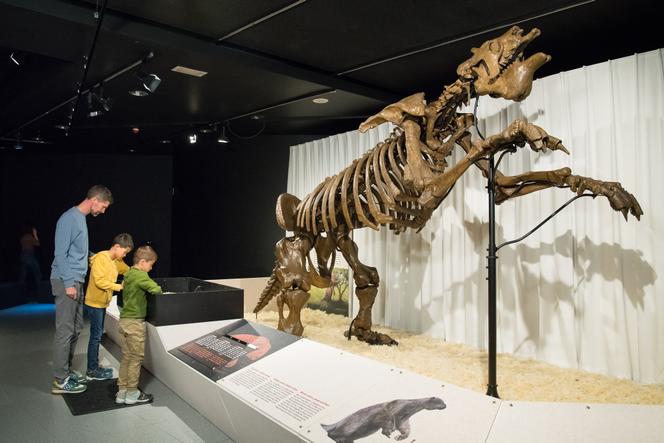


When visitors to Toulouse's Natural History Museum descend into the room where the "Giants" (Géants) exhibition has just opened, the staircase is overlooked by the open jaws of a megalodon, an extinct shark that makes the great white shark look like a sweet fish. The theme is clear. Welcome to excess, among those species which – following the extinction of the non-avian dinosaurs 66 million years ago – took up residence, made themselves comfortable and above all, grew in size to ecological niches that had become vacant. This megafauna in turn disappeared, but through the extraction and study of fossils, paleontology is helping to bring it back to life.
This exhibition, originally designed by Belgium's Royal Institute of Natural Sciences, has taken the approach of showing these animals life-size. Some are presented in the classic form of reconstructed skeletons, such as the saber-toothed feline American Megatherium, a 4-metric-ton giant sloth with a bear-like appearance, and the Gastornis laurenti, a 1.7-meter-high bird with a large beak, which plays the role of the regional find as it was discovered in the Aude region of southwestern France in 2018.
But the strongest guests take on a bolder, more aesthetically pleasing form with their silhouettes, a rather colossal origami with white facets cut out of insulation panels. The set design makes the most of these imposing bodies, either using them as labels or screens, removing certain panels to reveal the animal's large bones.
We move between the Titanoboa – a terrifying 15-meter snake that would have gobbled you up if you had lived 60 million years ago – the Baluchitherium – the most massive of land mammals, weighing in at 17 metric tons – and of course, the inevitable mammoth. Also worth mentioning is Gigantopithecus blacki, the largest known ape that became extinct around 300,000 years ago, impressing with its 3.7-meter height and 200 to 400 kilo weight.
And in fact, there are various reasons for this gigantism: better protection against the cold, defense against predators or competitive advantage during mating season. However, the exhibition focuses primarily on the giant with feet of clay aspect. Large size has its advantages, but also its disadvantages. "The Cope-Depéret rule states that 'the bigger a species gets, the closer it is to extinction, because it will be more sensitive to environmental changes'," said Francis Duranthon, Director of the Toulouse Museum.
With a touch of facetiousness, this enthusiastic paleontologist added that "we humans have grown by 20 centimetres since the 1914 war." And that, even if we feel quite small as we browse through the exhibition, we are nonetheless a large species: "Among vertebrates above 45 kilos, we are some of the giants."
You have 3.29% of this article left to read. The rest is for subscribers only.
